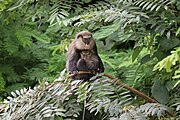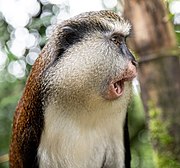Guenon
| Guenons[1] | |
|---|---|
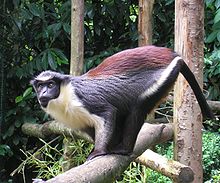
| |
| Diana monkey (C. diana) | |
| Scientific classification | |
| Domain: | Eukaryota |
| Kingdom: | Animalia |
| Phylum: | Chordata |
| Class: | Mammalia |
| Order: | Primates |
| Suborder: | Haplorhini |
| Infraorder: | Simiiformes |
| Family: | Cercopithecidae |
| Subfamily: | Cercopithecinae |
| Tribe: | Cercopithecini |
| Genus: | Cercopithecus Linnaeus, 1758 |
| Type species | |
| Species | |
|
See text | |
The guenons (
All members of the genus are
In the
Classification
The genus Cercopithecus, derived from the Ancient Greek terms κέρκος (kérkos, “tail”) and πίθηκος (píthēkos, "ape"), was named by Carl Linnaeus in 1758.
Species list
| Common name | Scientific name and subspecies | Range | Size and ecology | IUCN status and estimated population |
|---|---|---|---|---|
| Blue monkey | C. mitis Wolf, 1822 Sixteen subspecies
|
Sub-Saharan Africa
|
Size: 31–70 cm (12–28 in) long, plus 55–109 cm (22–43 in) tail[6] Habitat: Forest[7] Diet: Fruit and leaves, as well as invertebrates[8] |
LC
|
| Campbell's mona monkey | C. campbelli Waterhouse, 1838 |
Western Africa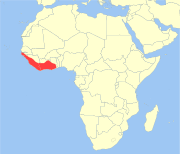
|
Size: 36–55 cm (14–22 in) long, plus 49–85 cm (19–33 in) tail[9] Habitat: Forest, savanna, and shrubland[10] Diet: Fruit, leaves, seeds and grains, as well as birds, bird eggs, small reptiles, and insects[9] |
NT
|
| Crested mona monkey | C. pogonias Bennett, 1833 Three subspecies
|
Central Africa
|
Size: 34–55 cm (13–22 in) long, plus 48–87 cm (19–34 in) tail[11] Habitat: Forest[12] Diet: Fruit and seeds, as well as leaves, flowers and insects[12] |
NT
|
| De Brazza's monkey | C. neglectus Schlegel, 1876 |
Central Africa
|
Size: 39–60 cm (15–24 in) long, plus 47–79 cm (19–31 in) tail[13] Habitat: Inland wetlands and forest[14] Diet: Fruit, as well as leaves, flowers, mushrooms, beetles, termites, and worms[15] |
LC
|
| Dent's mona monkey | C. denti Thomas, 1907 |
Central Africa
|
Size: 40–70 cm (16–28 in) long, plus 70–90 cm (28–35 in) tail[16] Habitat: Forest[17] Diet: Fruit and arthropods, as well as flowers, caterpillars, shoots, and leaves[17] |
LC
|
| Diana monkey | C. diana (Linnaeus, 1758) |
Western Africa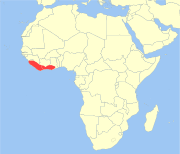
|
Size: 40–55 cm (16–22 in) long, plus 50–75 cm (20–30 in) tail[18] Habitat: Forest[19] Diet: Fruit, flowers, leaves, insects, and other invertebrates[18] |
EN
|
| Greater spot-nosed monkey | C. nictitans (Linnaeus, 1766) Five subspecies
|
Western Africa
|
Size: 40–57 cm (16–22 in) long, plus 56–100 cm (22–39 in) tail[20] Habitat: Forest[21] Diet: Fruits and seeds, as well as leaves and insects[22] |
NT
|
| Hamlyn's monkey | C. hamlyni Pocock, 1907 Two subspecies
|
Central Africa
|
Size: 43–63 cm (17–25 in) long, plus 49–63 cm (19–25 in) tail[23] Habitat: Forest[24] Diet: Shoots, leaves, plants, and herbs, as well as fruit and seeds[25] |
VU
|
| Lesser spot-nosed monkey | C. petaurista (Schreber, 1774) Two subspecies
|
Western Africa
|
Size: 29–53 cm (11–21 in) long, plus 57–78 cm (22–31 in) tail[26] Habitat: Forest[27] Diet: Fruit as well as insects[26] |
NT
|
| Lesula | C. lomamiensis Hart et al., 2012 |
Central Africa
|
Size: 40–65 cm (16–26 in) long, plus 40–65 cm (16–26 in) tail[28] Habitat: Forest[29] Diet: Leaves, fruits and flowers[30] |
VU
|
| Lowe's mona monkey | C. lowei Thomas, 1923 |
Western Africa (in green)
|
Size: 36–55 cm (14–22 in) long, plus 54–85 cm (21–33 in) tail[31] Habitat: Forest and savanna[32] Diet: Fruit and insects[31] |
VU
|
| Mona monkey | C. mona (Schreber, 1774) |
Western Africa
|
Size: 32–53 cm (13–21 in) long, plus 67–90 cm (26–35 in) tail[33] Habitat: Forest[34] Diet: Fruit, sprouts, leaves, and invertebrates[33] |
NT
|
| Moustached guenon | C. cephus (Linnaeus, 1758) Three subspecies
|
Western Africa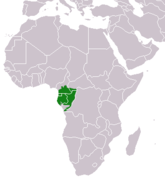
|
Size: 44–60 cm (17–24 in) long, plus 66–99 cm (26–39 in) tail[35] Habitat: Forest[36] Diet: Fruit, as well as seeds, leaves, insects, and eggs[37] |
LC
|
| Red-eared guenon | C. erythrotis Waterhouse, 1838 Two subspecies
|
Western Africa
|
Size: 36–55 cm (14–22 in) long, plus 46–77 cm (18–30 in) tail[38] Habitat: Forest[39] Diet: Fruit, as well as leaves, shoots and arthropods[39] |
VU
|
| Red-tailed monkey | C. ascanius (Audebert, 1799) Five subspecies
|
Central Africa
|
Size: 34–55 cm (13–22 in) long, plus 67–92 cm (26–36 in) tail[40] Habitat: Forest[41] Diet: Fruit, as well as leaves, insects, flowers, buds, and tree gum[42] |
LC
|
| Roloway monkey | C. roloway (Schreber, 1774) |
Western Africa
|
Size: 44–62 cm (17–24 in) long, plus 70–91 cm (28–36 in) tail[43] Habitat: Forest[44] Diet: Insects, as well as seeds, fruit, and leaves[43] |
CR
|
| Sclater's guenon | C. sclateri Pocock, 1904 |
Western Africa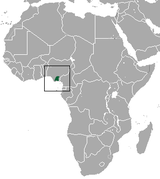
|
Size: 32–38 cm (13–15 in) long, plus 61–85 cm (24–33 in) tail[45] Habitat: Forest[46] Diet: Fruit, as well as insects, flowers and leaves[47] |
EN
|
| White-throated guenon | C. erythrogaster Gray, 1866 Two subspecies
|
Western Africa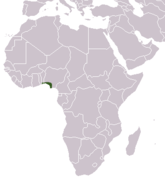
|
Size: 38–46 cm (15–18 in) long, plus 58–70 cm (23–28 in) tail[26] Habitat: Forest and inland wetlands[48] Diet: Fruit[48] |
EN
|
| Wolf's mona monkey | C. wolfi Meyer, 1891 Three subspecies
|
Central Africa | Size: 44–52 cm (17–20 in) long, plus 69–83 cm (27–33 in) tail[49] Habitat: Forest[50] Diet: Fruit, leaves, seeds, and flowers[49] |
NT
|
Hybrids
The red-tailed monkey (Cercopithecus ascanius) is known to hybridize with the blue monkey (C. mitis) in several locations in the wild in Africa.[51]
References
- ^ OCLC 62265494.
- ^ guenon /gəˈnoʊn/ n. M19. [Fr., of uncertain origin.] (The New Shorter Oxford English Dictionary, Clarendon Press, Oxford, Vol. 1 A-M, 1993 edition, see page 1,157)
- ISBN 2-85036-469-X, see page 1,056)
- ^ "Allochrocebus". ITIS. Retrieved 2019-07-18.
- ^ "Allochrocebus". Mammal Diversity Database. Retrieved 2019-07-18.
- ^ Kingdon 2015, p. 175
- ^ .
- ^ Strawder, Nicole (2001). "Cercopithecus mitis". Animal Diversity Web. University of Michigan. Archived from the original on August 12, 2023. Retrieved July 24, 2023.
- ^ a b Leinberger, Kaitlynn (2022). "Cercopithecus campbelli". Animal Diversity Web. University of Michigan. Archived from the original on August 12, 2023. Retrieved July 24, 2023.
- ^ .
- ^ Kingdon 2015, p. 168
- ^ .
- ^ Kingdon 2015, p. 161
- ^ .
- ^ Stein, Joshua (2002). "Cercopithecus neglectus". Animal Diversity Web. University of Michigan. Archived from the original on June 26, 2023. Retrieved August 16, 2023.
- ^ Kingdon 2015, p. 166
- ^ .
- ^ a b Kennedy, Karen (2023). "Cercopithecus diana". Animal Diversity Web. University of Michigan. Archived from the original on March 6, 2016. Retrieved July 24, 2023.
- ^ .
- ^ Kingdon 2015, p. 174
- ^ .
- ^ Neinast, Alexandra (2012). "Cercopithecus nictitans". Animal Diversity Web. University of Michigan. Archived from the original on July 26, 2023. Retrieved August 16, 2023.
- ^ Kingdon 2015, p. 170
- ^ .
- ^ Bharti, Nita (2000). "Cercopithecus hamlyni". Animal Diversity Web. University of Michigan. Archived from the original on July 24, 2023. Retrieved July 24, 2023.
- ^ a b c Kingdon 2015, p. 179
- ^ .
- ^ Kingdon 2015, p. 171
- ^ .
- ^ Antosh, Bonnie (2013). "Cercopithecus lomamiensis". Animal Diversity Web. University of Michigan. Archived from the original on August 16, 2023. Retrieved August 16, 2023.
- ^ a b Kingdon 2015, p. 165
- ^ .
- ^ a b Liu, Sonia (2000). "Cercopithecus mona". Animal Diversity Web. University of Michigan. Archived from the original on February 20, 2023. Retrieved July 24, 2023.
- ^ .
- ^ Kingdon 2015, p. 181
- ^ .
- ^ Miretti, Juan (2006). "Cercopithecus cephus". Animal Diversity Web. University of Michigan. Archived from the original on July 24, 2023. Retrieved July 24, 2023.
- ^ Kingdon 2015, p. 182
- ^ .
- ^ Kingdon 2015, p. 183
- ^ .
- ^ Davis, Sarah (2002). "Cercopithecus ascanius". Animal Diversity Web. University of Michigan. Archived from the original on April 1, 2023. Retrieved July 24, 2023.
- ^ a b Johnson, Kelsey (2015). "Cercopithecus roloway". Animal Diversity Web. University of Michigan. Archived from the original on June 18, 2021. Retrieved July 24, 2023.
- ^ .
- ^ Kingdon 2015, p. 180
- ^ .
- ^ Law, Jason (2004). "Cercopithecus sclateri". Animal Diversity Web. University of Michigan. Archived from the original on July 26, 2023. Retrieved August 16, 2023.
- ^ .
- ^ a b Platter, Branden (2008). "Cercopithecus wolfi". Animal Diversity Web. University of Michigan. Archived from the original on July 24, 2023. Retrieved July 24, 2023.
- ^ .
- ISBN 0-9648825-0-7.
Sources
- Kingdon, Jonathan (2015). The Kingdon Field Guide to African Mammals (Second ed.). ISBN 978-1-4729-2531-2.
External links
 Media related to Cercopithecus at Wikimedia Commons
Media related to Cercopithecus at Wikimedia Commons- Primate Info Net Cercopithecus Factsheets


